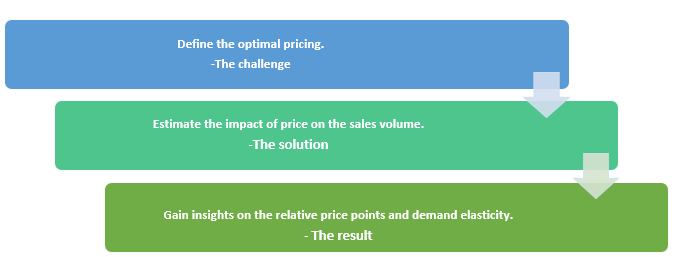Table of Contents
What You’ll Find in this Case Study:
- About the Client
- Area of Engagement
- Industry Overview
- Challenges Faced by the Client
- Solution and Business Impact
- Price Analysis Solution Predictive Insights
Highlights of the Case Study
| Particulars | Description |
| Client | Major frozen food supplier with operations spread across the globe |
| Business Challenge | Difficulty defining the optimal price strategy to understand what drives the buying decisions |
| Solution Impact | Understood the impact of price differentials on market share and optimize their price based on revenues and profitability |
The client – A renowned frozen food supplier with operations spread across the globe
Area of engagement – Pricing analytics
The frozen food industry is witnessing exponential growth with the rise in disposable income and the growing desire for convenience. The ease of use associated with the products is compelling consumers to shift their preferences toward the products and reduce their cooking and clean up time. With the rise in product innovations, prominent frozen food suppliers are planning to enhance their production capabilities to retain their position in the market. Moreover, the rising geriatric population and the increasing preferences for favor instant meals also contribute to the growth of the frozen food industry. Although the industry is witnessing promising growth, several factors may curtail the growth of the frozen food market. They include:
- Inadequate cold chain infrastructure: Frozen food is normally kept at a set temperature, and any fluctuations in the temperature can further lead to the deterioration in the food quality. So, it becomes essential for the frozen food suppliers to ensure that they meet the required technical capabilities to reduce the waste and damage of food due to frequent handling and transfer. Moreover, frozen food suppliers need to devise new strategies to develop better cold storage systems and ensure better conditions in the warehouses.
If you wish to explore our pricing analytics success stories,
Request a free pilot- Fresh over frozen: The consumers’ buying preferences are changing, and people prefer the need for natural ingredients in their food products. The numerous advantages of fresh products over frozen products, such as nutritional benefits, are compelling companies to add more natural flavors into their product offerings.
To address such challenges and understand the relative pricing trends in the market, businesses are facing the need for a price analysis solution. In the frozen food market, price analysis solution helps suppliers understand the price points and identify the internal and external factors affecting profitability. Moreover, businesses can identify the price opportunities and align its strategies to improve the business performance.
Types of Food & Beverage Pricing Strategies
1. Competitive Pricing Strategy:
It involves setting prices based on what competitors charge for similar products, aiming to attract price-sensitive customers while maintaining profitability. Utilizing data analysis and AI-based tools, businesses can adapt strategies swiftly in response to market trends and competitor actions, ensuring they remain agile in the dynamic food and beverage industry.
2. Penetration Pricing Strategy:
This is a strategy where products are initially priced lower than the market average to gain rapid market share. For food and beverage businesses, this approach can be effective in introducing new products, especially in response to evolving customer trends and demands for innovative flavors like gourmet Italian food or fusion flavor twists.
3. Dynamic Pricing Strategy:
It involves adjusting prices in real-time based on factors such as demand, seasonality, and competitive landscape. Restaurants, from fine-dine establishments to quick-service restaurants (QSRs), can benefit from dynamic price to optimize profits, especially during peak hours or Trade Promotion like buy one get one free (BOGO) pricing strategies.
4. Cost-Plus Pricing Strategy:
It involves setting prices by adding a markup to the production cost, ensuring profitability. This method is commonly used by grocery product distributors and manufacturers. Leveraging price simulations and strategic planning, businesses can determine the right quantity and price structures for products in response to ingredient and commodity price shifts, maintaining a profitable business model.
Tips for Setting a Modern, Efficient & Agile Food & Beverage Pricing Strategy
1. Embrace Dynamic Pricing for Agility:
In the ever-evolving landscape of the food and beverage industry, implementing a strategy is paramount. Utilizing AI-based analytical tools and price simulations enables businesses to adjust prices in real-time based on market trends, demand for new products, and ingredient/commodity price shifts. This agility is crucial for staying competitive and ensuring a profitable business model.
2. Adopt Customer-Centric Hybrid Pricing:
A successful food and beverage strategy involves adopting a hybrid approach that considers various customer segments and preferences. Leverage data analysis to understand customer trends, and implement relative strategies, such as Buy One Get One Free (BOGO) or complimentary item pricing, to enhance customer satisfaction and drive profitability across different types of restaurants, including fine-dine, casual dining, and QSRs.
3. Optimize Channel Diversification for Retail Success:
Achieving efficiency in the food and beverage industry requires strategic channel diversification. For grocery product distributors and manufacturers, this involves adapting pricing strategies to accommodate various distribution channels, considering lead and delivery times. An effective retail strategy, supported by Excel spreadsheets and strategic plans, ensures the right pricing structure for different retail channels, enhancing business outcomes.
4. Ensure Accurate Menu Pricing in Restaurants:
For restaurant owners, setting the right menu price is a critical aspect of success. Considerations such as portion sizes, menu descriptions, and cost-plus markup price must align with the type of restaurant and customer expectations. Using gross margin value (GMV) calculations and Excel spreadsheets, restaurateurs can ensure profitability while offering gourmet Italian food, fusion flavor twists, or popular items like salted fries and cheese fries, creating a positive dining experience and maximizing restaurant profit.
Choosing the Right Pricing Strategy for Your Business:
Selecting the optimal pricing strategy requires considering factors like customer segments, lead times, and market trends. Businesses, whether in retail or the restaurant industry, should leverage AI-based analytical tools to align price strategies with customer behaviors, ensuring the right price and quantity for each menu item. From relative price on restaurant menus to channel diversification for manufacturers, a strategic blend of these strategies will depend on the specific needs and goals of the business, ultimately driving business outcomes and sustained profitability in the competitive food and beverage landscape.
Food Pricing Strategies Challenges
The client, a renowned frozen food supplier, wanted to define the optimal pricing strategy to understand what drives the buying decisions. With the help of a price analysis solution, the client wanted to maximize their revenues in terms of their sales and profit margins. The frozen food supplier also wanted to identify the right price points to maximize sales and promote pricing to achieve profit targets. The primary objective of the frozen food supplier was to streamline its price patterns to understand the impact of price promotion on brand equity.
To more about how our pricing analytics solutions can help you achieve desired business outcomes,
Request a free proposalBenefits and the Business Impact
Strategies that we recommend to improve product pricing and enhance the ROI.
The price analysis solution offered by Quantzig helped the frozen food supplier estimate the impact of price on sales volume. The frozen food supplier was able to understand the impact of price differentials on market share and optimize their price based on revenues and profitability. The price analysis solution also offered insightful ways for the frozen food supplier to predict the bid prices based on the historical data and position their products effectively so that they are in line with the competition.
Why Food & Beverage Pricing is Different – Important Points for Your Pricing Strategy
1. Unique Customer Segments and Preferences:
It differs due to diverse customer segments with varying preferences. Understanding these preferences is crucial for crafting effective strategies, whether it’s for fine-dine restaurants offering gourmet Italian food or quick-service restaurants (QSRs) experimenting with fusion flavor twists. Data analysis is key to identifying and responding to evolving customer trends, ensuring that price aligns with the demands of specific target markets.
2. Ingredient and Commodity Price Volatility:
The food and beverage industry are highly sensitive to ingredient and commodity price shifts, impacting the overall cost structure. Cost-plus pricing strategies and agile pricing become essential for grocery product distributors and manufacturers to navigate these fluctuations. Strategic plans, supported by price simulations and AI-based analytical tools, enable businesses to adjust price in real-time, ensuring profitability and sustained business outcomes.
3. Menu Complexity and Description Influence:
The intricacies of a restaurant menu, such as relative and complimentary item pricing, and portion sizes, make food and beverage price unique. Right price and quantity considerations depend on the type of restaurant – be it a fine-dine establishment, a casual dining restaurant, or a QSR. Effective menu descriptions play a vital role, guiding customers toward choices that align with their preferences and maximizing gross margin value (GMV).
4. Channel Diversification in Retail Strategy:
Channel diversification is crucial in the food and beverage industry, with retail strategy extending beyond traditional brick-and-mortar stores. Whether exploring new distribution channels or optimizing eCommerce listings management, businesses need to adapt their strategies accordingly. Dynamic price and competitive price strategies become powerful tools for ensuring the right price in various retail channels, responding to market trends and the demand for new products effectively.
Predictive Insights
The price analysis engagement offered granular insights on the relative price points, demand elasticity measures, and optimization to maximize profit margins. With the help of pricing agility, the frozen food supplier was able to stay ahead of the curve and enhance its performance in the market. The engagement also assisted the client to monitor the market closely and anticipate the impact of a price change on promotional campaigns.



